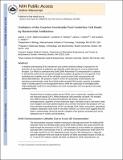Oxidation of the Guanine Nucleotide Pool Underlies Cell Death by Bactericidal Antibiotics
Author(s)
Foti, James J.; Devadoss, Babho; Walker, Graham C.; Winkler, Jonathan A.; Collins, James J.
DownloadWalker_Oxidation.pdf (1.071Mb)
PUBLISHER_POLICY
Publisher Policy
Article is made available in accordance with the publisher's policy and may be subject to US copyright law. Please refer to the publisher's site for terms of use.
Terms of use
Metadata
Show full item recordAbstract
A detailed understanding of the mechanisms that underlie antibiotic killing is important for the derivation of new classes of antibiotics and clinically useful adjuvants for current antimicrobial therapies. Our efforts to understand why DinB (DNA polymerase IV) overproduction is cytotoxic to Escherichia coli led to the unexpected insight that oxidation of guanine to 8-oxo-guanine in the nucleotide pool underlies much of the cell death caused by both DinB overproduction and bactericidal antibiotics. We propose a model in which the cytotoxicity of beta-lactams and quinolones predominantly results from lethal double-strand DNA breaks caused by incomplete repair of closely spaced 8-oxo-deoxyguanosine lesions, whereas the cytotoxicity of aminoglycosides might additionally result from mistranslation due to the incorporation of 8-oxo-guanine into newly synthesized RNAs.
Date issued
2012-04Department
Massachusetts Institute of Technology. Department of BiologyJournal
Science
Publisher
American Association for the Advancement of Science (AAAS)
Citation
Foti, J. J., B. Devadoss, J. A. Winkler, J. J. Collins, and G. C. Walker. “Oxidation of the Guanine Nucleotide Pool Underlies Cell Death by Bactericidal Antibiotics.” Science 336, no. 6079 (April 20, 2012): 315–319.
Version: Author's final manuscript
ISSN
0036-8075
1095-9203